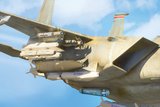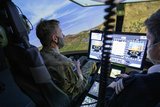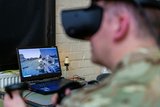Controlling the Skies - Fighter Aircraft Central to AsPac Defence Spending (Studio)
Aircraft with advanced air dominance capabilities have emerged as a top acquisition priority for countries across the Asia-Pacific, driven by the evolving geopolitical landscape.
Several nations are pursuing fighter aircraft programmes, which are set to see significant progress over the coming decade.
The evolution of adversary capabilities is one of the major factors driving Asia-Pacific countries to upgrade their ageing fleets, according to Ilker Aktaşoğlu, Shephard senior analyst – air
According to Shephard Defence Insight, spending on new aircraft is set to peak at just over $15 billion in 2024, before slowly tapering off later in the decade as several major programmes reach their conclusion.
Three countries will dominate spending in the region: India, Japan and South Korea.
According to Defence Insight forecasts, India is set to be the most significant player in the Asia-Pacific market, with a forecasted need for 383 combat jets, along with 278 light attack/trainer aircraft.
The country alone will account for just over a third of the regional demand.
There is a wide range of projects under focus for New Delhi, such as the Advanced Medium Combat Aircraft (AMCA), the Multirole Combat Aircraft (MRCA), as well as F-15 and F/A-18 solutions.
India, Japan and South Korea will be the highest-spending nations for combat and light attack/trainer aircraft programmes. (Source: Shephard Defence Insight. Full-size version)
Japan is forecast to be the second-biggest regional spender, according to Defence Insight. The nation is planning the new F-X (also known as the F-3) sixth-generation air superiority stealth fighter to replace its F-2 fleet from 2030.
The programme will cost just under $47 billion, while the Japan Air Self-Defense Force would require about 100 platforms to replace its entire fleet of F-2 aircraft.
Tokyo is also expected to replace 99 F-15s (unmodernised) from 2023, with a plan to purchase 105 F-35 aircraft, bringing its total F-35 fleet to 147 platforms and making the country the biggest export customer for the F-35.
They additionally are moving forward with the F-15JSI program, which includes replacing the existing AN/APG-63 radar system with the more modern APG-82 AESA radar system baseline from Raytheon Intelligence & Space (RI&S), with the company working closely with aircraft manufacturer Boeing.
For many western companies, Japan holds a particular interest in the air dominance domain.
'Our customers face new challenges every day – whether that is the evolution of peer threats to the development of next-generation technology. That is where RI&S comes in,' said Michelle Styczynski, vice president, F-15 programmes at Raytheon Intelligence & Space.
'We provide comprehensive solutions to our allies, Japan, in particular, who need to keep their military edge, especially in the skies, and meet new security challenges.'
Styczynski placed the company's work with Japan into the context of the regional environment. She noted that 'when unknown aircraft threaten Japanese airspace, Japanese fighters with RI&S fire control radars, identification friend or foe (IFF), navigation systems, and air-to-air missiles scramble, locate, identify, and ward off these potential adversaries'.
'Japan has operated the largest F-15 fleet outside the US for many years and aims to continue upgrading these aircraft with the next F-15JSI programme,' she added.
'In addition to F-15s, they began procuring F-35s in 2009. They've also committed to building a next generation fighter and see a real need for unmanned systems. Our partnership with Japan is essential in ensuring their F-15s, future aircraft purchases and/or development programmes are equipped with the best radar, sensors and electronic warfare technologies.'
She also noted that the country's 2019 National Defense Program Guidelines' clarify that space, cyber and electronic warfare are national security priorities for Japan – three core capabilities for RI&S'.
The third-biggest spender in the region is South Korea, which is developing its KF-X fighter programme with Indonesia, modernising the F-15K and planning to bring the F-35 JSF into their fleet. The country has also ordered TA-50 Block II aircraft to meet its combat pilot training requirements.
Beyond these three big spenders, there is a range of other quickly developing air dominance markets in Asia-Pacific. Indonesia is a significant market in its own right, as is Australia.
Styczynski said RI&S’ air dominance technologies, including the Next-Generation Jammer Mid-Band (NGJ-MB), radar warning receivers and fire control radars are in service across the region.
Raytheon Technologies has seen significant growth in Australia in recent decades, she noted, now comprising 1,500 employees focused on a range of defence needs.
'We leverage the capabilities, scalability and power of overall Raytheon Technologies to help our customers achieve mission success, partner with local industry and also support their defence and security requirements,' Styczynski explained.
'For example, in Australia, we established a local presence in 1999 called Raytheon Australia, which has grown to become the nation's leading provider of capabilities for the Australian Defence Force and is fully dedicated to developing a sovereign workforce and comprehensive capability for Australia. So, Raytheon Australia's team of 1,500 employees, which includes about 700 engineers and technicians, has positioned us successfully to deliver on a range of diverse programmes in joint battlespace systems, mission systems, above water systems, underwater systems, as well as weapons.'
Uncontracted opportunities account for 58% of total combat and light attack/trainer aircraft programmes by value in Asia. (Source: Shephard Defence Insight. Full-size version)
Beyond this, Styczynski highlighted Singapore as a primary focus for air dominance activities in the region.
‘Singapore has been a longstanding partner in the region, and has been on the forefront of some of our greatest technologies. Over the years, we have worked collaboratively to provide comprehensive solutions to meet their unique security requirements. From our radars, to electronic warfare, to sensors, our range of open architecture technologies provides air dominance to ensure safe, successful and effective missions, every time. As the Republic of Singapore Air Force continues to pursue new technologies, we are ready provide the next set of solutions to maintain their competitive edge in the skies.’
For countries in Asia-Pacific and further afield, two significant trends are likely to drive the evolution of air dominance in the coming years, Styczynski added.
The first is a need for 'forward-thinking technology that is widely available across platforms, and developing these technologies in ways that minimise delays and disruptions to upgrades'.
Beyond this, she highlighted a growing need for integrated capabilities, such as radars, sensors, and electronic warfare (EW) solutions, including AESA radars like APG-82(v)1, radar warning receivers, and NGJ-MB.
Such technologies aim to 'cover aircraft and aircrew end-to-end to increase survivability and mission completion', she added.
'Our mission suite of capabilities can be integrated into existing technology and improve sustainability opportunities.'
More from Studio
-
![Combat-proven capabilities: How precision-strike systems are evolving for tomorrow’s battlespace (podcast)]()
Combat-proven capabilities: How precision-strike systems are evolving for tomorrow’s battlespace (podcast)
Combat-tested technology is being reshaped to counter A2/AD threats, reduce reliance on GPS and enable faster, more autonomous targeting in complex environments. In this special podcast, experts explain how the evolving threat landscape is shaping next-generation strike capabilities.
-
![Energy evolution: How laser defence systems are powering the next phase of air defence (podcast)]()
Energy evolution: How laser defence systems are powering the next phase of air defence (podcast)
Laser-based air defence is moving from promise to deployment as global threats evolve. In this special podcast, we explore how high-energy laser systems are reshaping interception strategies.
-
![Intelligence advantage: How real-time GEOINT is reshaping military decision-making (Studio)]()
Intelligence advantage: How real-time GEOINT is reshaping military decision-making (Studio)
In today’s contested operational environment, adaptability is key. The new Geospatial-Intelligence as a Service (GEO IaaS) solution from Fujitsu and MAIAR empowers militaries by enabling intelligence advantage, combining advanced technology with human expertise to deliver actionable insights.
-
![Training Together: Unlocking Educational Excellence through Military and Industry Collaboration (Studio)]()
Training Together: Unlocking Educational Excellence through Military and Industry Collaboration (Studio)
Military training is ultimately about people. At Capita, training programmes are built on close engagement with partners, delivering an educational approach that can adapt to individual needs, cultivate leadership – and drive wider cultural change.
-
![Enhancing Military Training Through Digital Technology (Studio)]()
Enhancing Military Training Through Digital Technology (Studio)
Digital technologies offer huge opportunities for defence training. However, militaries must adopt an agile approach, placing the needs of their organisations and personnel at the centre of their efforts.
-
![Layered Defence: How new technologies are enhancing armoured vehicle survivability and manoeuvrability (Studio)]()
Layered Defence: How new technologies are enhancing armoured vehicle survivability and manoeuvrability (Studio)
As modern threats evolve, armoured fighting vehicles face a new era of challenges, from loitering munitions to kinetic energy projectiles. Advances in active, passive, and reactive protection systems are crucial to ensuring battlefield dominance, freedom of manouver and vehicle survivability.






















